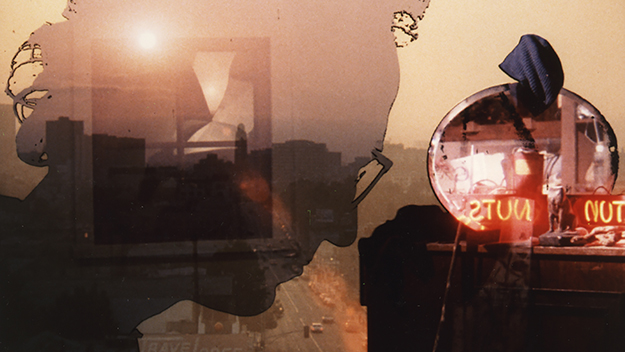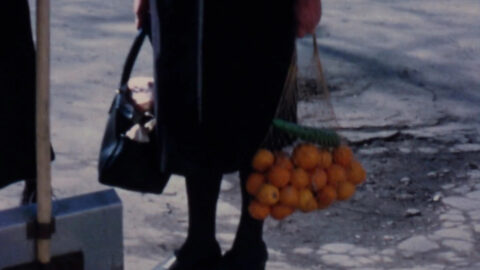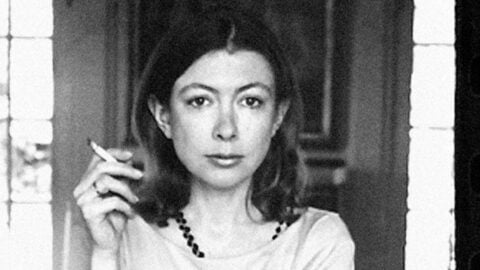All Connections Were Equally Meaningful: Didion’s Los Angeles and the Nonfiction Form
This article appeared in the March 3, 2022 edition of The Film Comment Letter, our free weekly newsletter featuring original film criticism and writing. Sign up for the Letter here.

Water and Power (Pat O’Neill, 1989)
The flight path into LAX runs east to west over the city. The planes line up around Vernon, cross the L.A. River, and skim the 405 freeway, landing just short of the beach. The passenger gets a pretty good overview of what to expect on the ground: a kind of giant neural network spilling over uneven terrain into oblivion.
“Confronted with sudden disaster,” wrote Joan Didion, “we all focus on how unremarkable the circumstances were in which the unthinkable occurred, the clear blue sky from which the plane fell, the routine errand that ended on the shoulder with the car in flames…” In the final approach, the planes pass just to the left of Inglewood Park, the cemetery where my dad’s ashes were buried following his sudden death. I always try to get a right-side window seat.
I moved to Los Angeles a few months after the funeral to attend film school. I was 26 and full of affectations, my face one among the city’s many sun-reflective surfaces, concealing fresh grief. The following summer my limbs started going numb, and when I was diagnosed with multiple sclerosis, I kept it to myself. In the cross-section images of my brain, the doctor pointed to the handful of dark spots where the circuitry had frayed (MS causes inflamed neurons to harden, scar, and effectively die). That same night, I tearfully waded through a website for the newly diagnosed, where I came across the following passage:
I was told that the disorder was not really in my eyes, but in my central nervous system. I might or might not experience symptoms of neural damage all my life. These symptoms, which might or might not appear, might or might not involve my eyes. They might or might not involve my arms or legs, they might or might not be disabling.
This excerpt is from Didion’s essay “The White Album,” but it cuts off before the distinctly Didion-esque parsing: “The condition had a name, the kind of name usually associated with telethons.” Confronted with a dying brain, I welcomed her dry-ice levity. In fact I had read “The White Album” before, but had no memory of Didion’s MS diagnosis among the more iconic sections of an essay that also deals with the Manson murders, a Black Panther Party meeting, a Doors recording session, and her fear of home invasion—all the discontinuities of late-’60s Los Angeles. Back then, her illness had been a nonfiction in the company of other nonfictions. But now, as a scared young person, I found it meaningful precisely because of her readiness to situate it thus—to investigate her own misfortunes as subjects no different from any others. It showed me, as a newcomer to nonfiction film, that you can explore anything.
***
“The White Album” consists of 15 numbered sections—some no longer than a paragraph, one a packing list—that might be called episodes. Episodic structures often radiate from a central nucleus, and help to bring a core theme or proposal into relief. “The White Album” does not function in this way. The segments remain oblique and lack explicit connective tissue. In the essay, Didion talks about a shift in her writing during this period, linking it to the phenomenon of nerve death and how the brain “finds other, unaffected nerves to carry the same messages”—which is to say, it makes new connections.
During the years when I found it necessary to revise the circuitry of my mind I discovered that I was no longer interested in whether the woman on the ledge outside the window on the sixteenth floor jumped or did not jump, or in why. I was interested only in the picture of her in my mind: her hair incandescent in the floodlights, her bare toes curled inward on the stone ledge. In this light all narrative was sentimental. In this light all connections were equally meaningful, and equally senseless.
In other words, the dots need not be connected, just deliberately composed, and the connections will take care of themselves. Essays like “Notes Toward a Dreampolitik” (also in The White Album, the like-named collection from 1979) offer a vital understanding of what it means for a piece of nonfiction to even be “about” something. Its four short chapters are examinations of, respectively, Pentecostal prophecy, the “biker film,” an aspiring actress living in “an invisible prairie of stucco bungalows,” and a Gamblers Anonymous meeting in Gardena. Together, they become the genesis for a larger thought about false promises and stratification in Southern California, a place where “Western civilization has its most superficial hold.” Her constellatory approach does not aim to decipher her subjects. Instead, it mirrors the decentered city, moving between its marginal locales and cinematic projections, scouring the manifest destiny of it all without degrading or blaming Los Angeles in the process.
Drive 45 minutes on the freeway in any direction, choose a prosaic exterior, and assume it contains a universe—that is the sense of creative possibility that Didion’s work imparted to me as a newcomer to nonfiction filmmaking. Didion’s taste for apparently minor diversions (swimming pools, a free trip to Hawaii), along with her sharp-eyed sensibility, were shared by a number of European filmmakers in the 1970s and ’80s in essayistic, language-driven films like Werner Herzog’s God’s Angry Man, about a televangelist; Julian Cooper’s Reyner Banham Loves Los Angeles, which surveys the city’s disregarded architecture and features a talking car; Babette Mangolte’s eight-minute There? Where?, about the freeways; and Agnès Varda’s Mur murs, about public murals. (Varda’s astringent, lyrical fiction film Documenteur, made in 1981, also feels distinctly Didionesque.) By focusing squarely on facades—and thus, ironically, exposing the depths beneath the surface of a city that architect Anthony Lumsden lovingly described as non-directional and non-gravitational—these works subvert L.A.’s reputation as a cultural wasteland. As Herzog has recently claimed, L.A. is “the city with the most substance,” and the most to reveal about the psychic life of the nation. Its sprawling horizontality also makes it the proper place to critique the myth of illimitable progress. Thom Andersen’s Los Angeles Plays Itself and Pat O’Neill’s stunning Water and Power conduct such interrogations, mapping a terrain that hovers between the shoddy, the cinematic, and occasionally, the planetary. In private correspondence, Michael Almereyda wrote me that Water and Power seems to echo Didion’s sense of landscape and light, “whereby human behavior, even when projected into Hollywood fantasies, can seem as reduced, sun-scorched and unreadable as petroglyphs.”
While Didion’s essays may have had a corollary in artist-driven, independent films, she herself, with her husband John Gregory Dunne, earned a living as a Hollywood screenwriter, often supplying uncredited rewrites. (Didion and Dunne’s combative and occasionally screwball experiences in the industry are bitingly recounted in Dunne’s book Monster: Living Off the Big Screen.) IMDB lists six feature screenplays under Didion’s name, including Frank Perry’s underappreciated adaptation of her novel Play It As It Lays. Though she never ventured into nonfiction filmmaking, it’s exciting to imagine where Didion might have taken the form. What would a Didion voiceover be like? Averse to the loping assurances of an Adam Curtis but also to the overtly diaristic, perhaps she would forego it altogether. Didion’s “I” lay in the arrangement of her perceptions, or the way she triangulated off unexpected observers (such as her young daughter experiencing Georgia O’Keeffe’s paintings).
Her mind favored material detail. “I tried to think. I failed,” she said about her time in college. “My attention veered inexorably back to the specific, to the tangible, to what was generally considered, by everyone I knew then and for that matter have known since, the peripheral.” She never had the academic’s appetite for abstraction. The organizing principle of her writing was the unique tilt of her observations, which manifested in elements like sentence structure, which she likened to camera angles, or the resonance of an image (“I’m not a schizophrenic, nor do I take hallucinogens, but certain images do shimmer for me”), or simply the radius of the circle she drew around a thing that interested her. How far could she get from a subject and still keep it in focus?
Reading her work with this spatial metaphor in mind, I’m reminded of Les Blank’s portrait of Leon Russell, A Poem is A Naked Person, in which ever-widening spheres of activity around the musician’s Oklahoma studio—extended scenes include a building demolition, pleasure-seekers on a lake, and images of the moon going behind a cloud—seem to reveal crucial ingredients of Russell’s sound and psyche. Or of Alice Diop’s recent We (Nous), which presents a series of disconnected encounters in Paris’s banlieues, along with the director’s own home movies. The episodes are linked only by shots of the passenger trains that transport workers into the city, and conjure a psychic landscape emanating from real geographies of exclusion, calling to mind Didion’s writing about Lakewood or Gardena or Rancho Cucamonga. As in Didion’s essays, this eccentric approach turns toward the margins not as places that only exist in reference to the center, but in order to question the very logic that creates margins. In a city like Los Angeles, in which the center is actually hard to locate, digression is a natural approach to capturing the whole. This is what Didion understood, and I often think of her formal skill when confronted with the documentary industry’s wearying preoccupation with “relevance” and the formal strategies that follow this monomania, making productive discontinuities a hard sell.
***
Didion wrote that developing MS didn’t give her insight into what it was like to be old, but “what it was like to open the door to the stranger and find that the stranger did indeed have the knife.” I was fortunate to have reencountered The White Album on the day I was diagnosed. In one of its essays, Didion writes about her childhood taste for adventure tales in which, she observed, “salvation lay in extreme and doomed commitments.” What I took from her writing at that time was the wisdom to let your difficulties change you, to commit to understanding them in order to transform them. While her illness, like mine to date, remained largely in remission, it was an edge she lived with and wrote from.
In her 1965 essay on the Santa Ana winds, which blow into Los Angeles each year to spark inevitable fires, she writes: “The violence and the unpredictability of the Santa Ana affect the entire quality of life in Los Angeles, accentuate its impermanence, its unreliability. The winds show us how close to the edge we are.” Los Angeles is always on the verge of disappearing. You go back to film a building and the whole block is gone. Cliffs erode. Communities vanish. The plasticity is alarming. Reading Didion is like looking into a pot on a flame and watching the last bit of water evaporate into steam. Her essays are satisfying—and somehow cinematic—because she finds a way to hold that moment, to look at it, asking continually: how do you open up an image as it slips away? How do you sustain an edge?
Thanks to Tim Reid and Abby Sun for their insights as I researched this essay.
Courtney Stephens is a nonfiction and experimental filmmaker.





